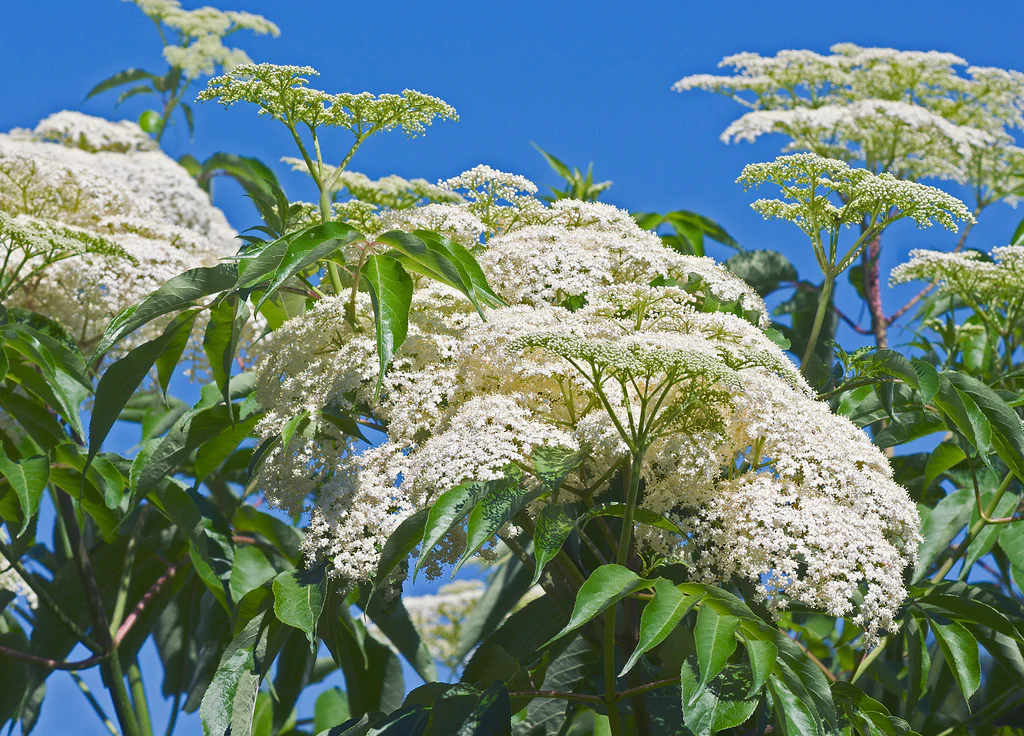There’s nothing quite like the lively sight and sound of birds fluttering around your garden. By choosing the right plants, you can turn your outdoor space into a natural bird sanctuary while adding beauty and charm. Shrubs are particularly valuable because they offer shelter, nesting sites, and seasonal food sources like berries and nectar. From vibrant blooms to lush foliage, these bird-friendly shrubs enhance your landscape and support local wildlife. Here are 10 gorgeous shrubs that birds (and you!) will love.
1. Viburnum (Viburnum spp.)

Viburnum shrubs are a top choice for bird lovers and garden enthusiasts alike. With their clusters of delicate flowers in spring and colorful berries in fall, they offer year-round interest. The berries are a favorite food source for species like robins, cardinals, and bluebirds. Viburnums come in a variety of forms, from compact to sprawling, and many varieties boast beautiful autumn foliage. Their dense structure also provides excellent nesting sites and cover for small birds, making them a valuable, multi-season addition to your garden.
2. Serviceberry (Amelanchier spp.)

Known for its delicate white blossoms in spring and striking fall color, Serviceberry is a native shrub beloved by birds and gardeners. After flowering, it produces sweet, blueberry-like berries that attract a wide array of birds, including cedar waxwings, orioles, and thrushes. Its dense branches offer shelter and nesting opportunities. Serviceberry adapts well to various soil types and looks stunning as a specimen shrub or part of a naturalized border. Its seasonal beauty combined with its bird-friendly nature makes it a must-have.
3. Red Twig Dogwood (Cornus sericea)

Red Twig Dogwood is a striking shrub prized for its vivid red stems, especially visible during the winter months. In spring and summer, it produces clusters of white flowers followed by white or bluish berries, which attract robins, woodpeckers, and waxwings. Its thick branches offer excellent cover and nesting sites. This hardy shrub thrives in a variety of conditions, including wet soils, making it a great option for rain gardens or naturalizing damp areas. It delivers bold, year-round garden interest while supporting local birdlife.
4. Winterberry Holly (Ilex verticillata)

A deciduous holly, Winterberry is famous for its bright red berries that persist well into winter, offering a vital food source for birds when other supplies are scarce. Species like mockingbirds, cedar waxwings, and chickadees flock to its fruit. In spring and summer, its glossy green leaves and small white flowers add charm to any landscape. Winterberry prefers moist, acidic soil and works beautifully in both formal and naturalistic plantings. Its colorful berries provide a festive winter focal point while nourishing local wildlife.
5. Beautyberry (Callicarpa americana)

Beautyberry lives up to its name with arching branches and clusters of vivid purple berries that appear in late summer and fall. The berries are irresistible to birds such as mockingbirds, finches, and towhees. Its soft green foliage turns golden in fall, enhancing its seasonal appeal. This low-maintenance shrub thrives in partial shade and well-drained soil. Its showy berries not only attract birds but also add unique color to the landscape when most other plants are fading, making it a standout feature in any garden.
6. Elderberry (Sambucus canadensis)

Elderberry is a fast-growing, native shrub that offers multiple benefits for both birds and gardeners. In early summer, it produces creamy white flower clusters, followed by dark purple berries beloved by over 50 bird species, including bluebirds, tanagers, and warblers. Its dense foliage provides valuable shelter and nesting opportunities. Elderberry prefers moist, well-drained soil and full sun to partial shade. Aside from attracting birds, the berries can be harvested for making jams and syrups, adding practical value to its ornamental beauty.
7. Butterfly Bush (Buddleja davidii)

Though often celebrated for attracting butterflies, Butterfly Bush is also a favorite of nectar-loving birds like hummingbirds. Its long, cone-shaped flower clusters bloom throughout summer in shades of purple, pink, white, and blue. The sweetly scented blooms draw in birds with their abundant nectar supply. Butterfly Bush grows best in full sun and well-drained soil. Prune it annually to maintain its shape and encourage new growth. Its vibrant flowers and wildlife appeal make it a brilliant focal point in any sunny garden.
8. Spicebush (Lindera benzoin)

Spicebush is a native shrub that earns its name from the pleasantly spicy scent of its leaves and stems. In early spring, it produces tiny yellow flowers, followed by bright red berries that attract birds like thrushes and vireos. Its dense, rounded shape provides excellent cover and nesting spots. Spicebush is adaptable to various soil types but thrives in moist, shady areas, making it ideal for woodland gardens or understory plantings. It offers beauty, fragrance, and vital resources for your feathered friends.
9. Mock Orange (Philadelphus coronarius)

Mock Orange is treasured for its fragrant, citrus-scented white blooms that appear in late spring to early summer. While its flowers delight the senses, the dense branching also provides cover and nesting opportunities for small birds like sparrows and wrens. Although its berries are modest compared to other shrubs, its thick structure makes it an excellent shelter plant. Mock Orange thrives in full sun to partial shade and well-drained soil. It’s a graceful, classic choice for cottage gardens and bird-friendly borders alike.
10. Chokeberry (Aronia arbutifolia)

Chokeberry is a versatile, resilient shrub valued for its glossy green leaves, white spring flowers, and bright red berries in fall. Birds like cardinals, bluebirds, and finches relish the tart berries, especially during colder months. Chokeberry’s foliage turns brilliant shades of red and orange in autumn, adding seasonal drama to your garden. It tolerates a range of soil conditions, including wet areas, making it suitable for rain gardens and naturalized settings. Its combination of ornamental and ecological benefits makes it an essential bird-friendly shrub.





Leave A Comment